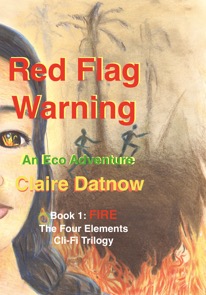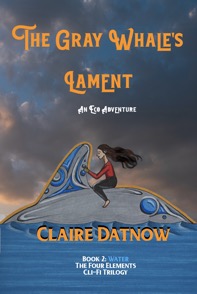Cli-FI Eco Adventures Middle Grade


The gale force winds of climate change are calling. They’re calling to scientists, writers, and artists to weave stories that will inspire young people to dream up a brighter future. After decades of misinformation, denial, and inadequate attempts to reduce the dire impact of climate change, the youth around the world are troubled, angry, and frustrated.
They are searching for ways to understand, and then take action. That is why writers, and artists need to dig deep to find ways to connect truthfully and authentically with the youth. Sadly middle graders and tweens have fewer age-appropriate books, relating to their lives and issues, to choose from. That is why I strive to write compelling stories interwoven with science that can educate, inspire, and empower them.
The epiphany that inspired me to begin writing Eco Adventures struck me one morning driving to work down the road winding through a wooded hillside. As I approached the bottom of the hill, I yelled out loud, “How dare they!” Overnight, a swath of red dirt had replaced a verdant forest. A forest of oak, hickory, poplar, and pine, which had sustained a rich diversity of life, had been bulldozed to a barren patch of clay. Just one ancient white oak, standing like a tower of hope, had been spared. The birds, possums, and squirrels had all fled for their lives.
After that aha moment, I imagined the oak, which I named Alba Maizie, telling its story to the neighborhood’s children. Nine months later, The Adventures of The Sizzling Six: The Lone Tree became the first Eco adventure to blossom into a stand-alone series of nine books published over the past decade.
Woven into these entertaining stories about six feisty girls, determined to save animals and the natural environment, is a serious theme. While my adventures do not sugar coat the truth, they are hopeful. I weave in scientific knowledge into my adventures to create plausible and inspiring endings in place of gloomy ones. A caveat: as environmental writers we have a responsibility to thoroughly research the scientific underpinnings of our stories. Pseudoscientific claims that appeal to ingrained fears and long-standing assumptions can become widely accepted, hampering action to reduce the harmful effects of climate change. Denial and book banning also prevent teens from becoming wise future stewards of our planet.
Following The Lone Tree, I created stories for The Sizzling Six series woven around North America’s disappearing freshwater mussels, the endangered Red-cockaded woodpecker in the longleaf pine forests, the threatened diamondback terrapins native to the coastal tidal marshes of the eastern and southern US, and the Cahaba lily found only in streams of Alabama and Georgia.
My focus widened to the international sphere with The Case of the Missing Piping Plovers, which chronicled the exciting discovery of the winter nesting grounds of Piping Plovers on a remote coral reef in the Bahamas. Monarch Mysteries (Book 6), follows the migration routes of the threatened Monarch butterflies from North America to the special Oyamel forest in Mexico. With Vanishing Birds (Book 9) I expanded my stories to include the entire length of the Atlantic migratory flyway from the Arctic to a remote island on the southernmost point of South America.
Recently, I completed the first two books in a climate fiction stand alone trilogy Red Flag Warning: An Eco Adventure and The Gray Whales Lament, An Eco Adventure, broadening the stories to global issues. This middle-grade climate fiction trilogy was sparked (pun intended) by the devastating wildfires, and sea level rising around the globe. The stories are told through the eyes of culturally and ethnically diverse teenagers, brought together by a powerful gift—the ability to communicate with animals.
Now, more than ever, I am convinced that scientists, educators, and artists need to use their talents to inspire students to see the interconnectedness of their world—to understand what happens in their town or country may impact other distant places on our planet. Now more than ever, I am committed to keep writing science-based environmental fiction that will ignite the imagination and show middle graders (and the young at heart) they can take wise action that makes a difference.

Looking back, I realize from my earliest childhood memories I’ve always been “in love” with the amazing natural world. That passion is what drives my stories. Back in the 1990s when I was teaching at in Birmingham, Alabama, public school, my students and I built a nature trail on the school grounds. One of my students recently penned this letter to me:
I remember when we started working on the Nature Trail. At first, I was excited to get out of the school building for any reason, but soon fell in love with being in the woods and learning about the plants and animals that we saw. I remember the invasive species Mrs. Datnow pointed out. This was my first introduction to the importance of native plant species on the continuing existence of native wildlife. Even now, as I hike and backpack with my own four children, I think fondly of the time as I point out the mayapple, trillium, the liverwort, and other plants . . . I often walked over to the trail with my best friend, who was part of the project, after school and on weekends. It was a wonderful place . . . to be free of our troubles and worries. The peace we found there has inspired me to teach my children about our world and how to preserve what we have been given, and to become wise stewards of nature.
Just recently I was thrilled to learn that the Alabama Audubon Society was restoring that trail and were naming it The Audubon Datnow Forest Preserve.
A lone voice can make a small difference to young people; however, many united voices can persuade the powers that be to do more to spread the message of environmental conservation. I know it’s not easy, but I hope to encourage writers and artists, scientists, and technologists to communicate their stories and their knowledge to the next generation.
In the not-too-distant future, young people in our neighborhoods and schools will have joined the workforce. Some will find themselves working as scientists discovering and studying creatures and plants on our planet’s highest mountains, deepest oceans, driest deserts, wettest rainforests, and in the concrete jungles of cities. Others will find themselves working for corporations, sitting behind desks, caring for patients in hospitals, standing on podiums, in classrooms teaching students, or running for political office. All of them will be making decisions, voting for leaders, and for actions that will, for better or worse, affect the health of our planet and the survival of life on this planet. That’s a huge responsibility for the older generation to place on their shoulders. So, what can we do to help them?
I am certain that students studying the natural sciences, from kindergarten to college, will blossom into the next generation of environmental leaders. They will understand the science and the issues underpinning society’s challenging ecological problems. And they will apply their knowledge to create a stronger connection between what must be done and how to get things done. Still, they need something more to close the chasm between cognition and action. They need something to electrify them, move them, to spur them on.
Science and literature can cross-fertilize one another. Storytellers need to understand the powerful methods of science which provide solutions to pressing problems. Scientists need to apply the building blocks of powerful writing and art to become better communicators. Although science and storytelling employ different methods, they share the WOW or the wonder that drives their vision, because curiosity and perseverance are at the heart of both disciplines. Science asks: how can we explain this WOW? Storytelling asks: how can we tell compelling narratives about this WOW?
I’m committed to keep writing science-based environmental/climate fiction especially for middle graders. As storytellers, we hold the keys to touch their hearts, to ignite their imagination to build a bridge to tomorrow, and to empower them to act for the greater good of humanity and the well-being of the Earth. We need to reject narratives of division. We need storytellers from all disciplines to blur boundaries, expand empathy, and stretch our capacity for caring. The winds of change are calling for narratives that will illuminate our vital connection to one another and to this precious blue planet on which all life depends.